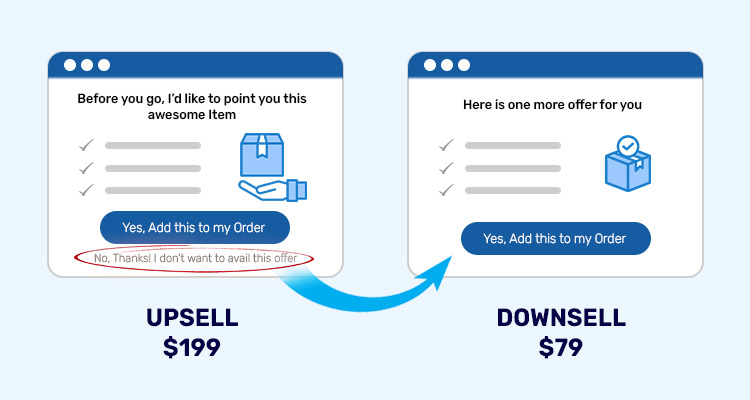
Ecommerce remains a rapidly growing but competitive market. With US online retail sales expected to top $1.02 trillion in 2022, more and more businesses are looking to either shift to online sales or to supplement their physical stores with an online presence.
With as many as 24 million eCommerce sites globally, getting your various strategies right has never been more important. Of course, your two primary aims are usually to maximize conversions and thus maximize revenue (and those all-important profits). Yet you are not alone in having those as your goals, so how do you edge ahead of your closest competitors?
You likely already employ a wide range of strategies to achieve those aims: personalized emails and retargeting, an optimized website offering a great customer experience, and so on. You also probably try to upsell your products, offering complementary products or more expensive alternatives to the one they are looking at.
However, not many companies focus on downselling, which is potentially a great opportunity to boost conversion rates and increase your total revenue on your eCommerce website. But just what is downselling? And more importantly, how can you use it to increase those vital metrics and see a better bottom line?
What is Downselling?
Downselling is simply the opposite of upselling. It is when you offer a customer a product that is cheaper than the one they had been looking at, but chose not to buy. Why on earth would you offer something cheaper? If a customer has decided not to buy a product, the most common reason for that decision is the pricing of the product.

For example, let’s say you run a physical computer shop. A customer has been looking at a particular model but it is outside of his planned budget. Rather than see him walk out of your store without making a purchase, you use your knowledge to find and offer him a product within his budget that meets most of his needs. That is downselling in action.
Downselling can help with any area of your eCommerce business, whether you are looking to improve sales on eBay or to increase revenue directly from your website. It can not only increase your total sales, but also offer you other benefits too. Knowing how to downsell and what benefits that tactic will bring to your business can make a tangible difference.
The Benefits of Downselling
There are many potential benefits to downselling, but let’s focus on three of the main ones:
1. Revenue booster
How are your eCommerce metrics? In particular, how are your cart abandonment rates and your bounce rates? Every one of those customers that leaves your site without making a purchase represents a lost opportunity, and with downselling you can seize those opportunities. Average bounce rates in the US sit at around 43%; that’s a lot of lost customers.
Cart abandonment represents even more lost opportunities than bounce rates, with the averages ranging from just under 70% to more than 85%. Of course, there are various reasons why people abandon carts, but the extra costs (of shipping) and total order cost are two major ones.

You may not recapture every opportunity through downselling, but it may make a significant difference. There is also a likelihood that customers will return to your site if they are happy with the downselling you have offered, thus adding to their potential CLV (customer lifetime value).
Many eCommerce businesses have limited warehouse space and understocking or overstocking can be a major issue. Downselling can help when you have overstocked products that are at lower price levels than other similar items. So, downselling can not only help your customer and boost revenue, it can also help you reduce overstock.
2. Attract a wider audience
Unless you are offering high-end, high-cost goods, you really want to attract as broad a demographic audience as possible to maximize sales and revenue. Customers have budgets that will vary greatly, from someone on a tight budget looking for a bargain, to someone with a platinum card that is not bothered about pricing.
By including downselling as part of your strategy, you are appealing to every level of budget. It can help you avoid offering discounts on products, offering free shipping to solve cart abandonment issues, and it can also help you maintain a high level of brand integrity and awareness. It can mean more people pressing that crucial buy button!
Of course, you will have several levels of customers, and it can often be the case that customers with a lower average spend per visit can have a higher CLV (customer lifetime value). When you downsell to a new customer, they may be spending less on that, and subsequent visits, but you increase the chances of them spending more over their lifetime with you.
3. Retention and loyalty

Customer retention rates can vary greatly, but are around 63% for the retail sector. Retention of customers is important to any business as it increases CLV, reduces CAC (customer acquisition cost), builds brand loyalty, and increases awareness of your brand. The other advantage is that loyal customers can become brand ambassadors and refer more customers to your business.
Think of downselling as displaying your honesty. By offering a cheaper product than they were originally looking at, they will appreciate being offered an alternative that may be kinder to their budget. That means increased levels of customer satisfaction and an higher likelihood that they will shop with you in the future.
As already mentioned, you should not always focus on the average spend per visit, but more on retaining that customer and increasing their lifetime value to your business. Would you rather have a customer who spends an average of $100 over four visits or one who spends an average of $50 over 10 visits? Downselling can help improve the chances of the latter scenario.
How to Start Downselling on Your eCommerce Website
1. Follow downselling best practices.
As with other sales tactics, you should consider what best practices best suit your business. While there will be many similarities to how you cross-sell or upsell, you should also be aware of the differences too. Consider implementing the following into any downsell strategy:
Get the timing right.
If you are going to implement downselling, then timing is everything. If you introduce cheaper alternatives too early, then you run the risk of losing a higher value sale. You may also put people off altogether and end up with no sale at all. Use downselling only when it becomes apparent that they won’t buy at the higher price point.
Avoid pushiness.
Very few people appreciate pushiness and this can be especially true in a downselling scenario. If you are too pushy, then not only do you lose that sale, but you also risk losing the customer altogether as they will be reluctant to use your site again.
Test your tactics.
As with other areas of your sales and marketing tactics, you may not get things right the first time. So, be prepared to tweak things as you move forward, including factors such as price points, different offers, free or discounted shipping, and other personalized triggers based on customer behavior. Testing is essential in any area of your strategies; think of smoke testing meaning when you develop software, for example.
All three of those best practices are factors that can be improved upon with time and also depend heavily on data. Study your data closely and understand customer behaviors on your site so that you can meet their needs better.
2. Start downselling now.
So, you can see the benefits of downselling and also have some idea of the best practices you can adopt. But how do you actually undertake the process of downselling? It may feel a little unnatural at first to offer customers cheaper products than what they have been looking at, but it is a tactic that can help with your bottom line.
If you are new to downselling, then you may be unsure how to approach it at first. As with other tactics, there are several ways to downsell, but these four suggestions may be the best to adopt:
Live chat/support
Live chat already produces the highest levels of customer satisfaction (as high as 81%). This makes it a great choice when it comes to direct selling, whether you’re upselling, cross-selling, or downselling. By using an efficient live chat app, your agents can downsell when necessary and close more sales.
You may already be targeting customers who abandon their cart before making a purchase. While investigating why they abandoned their cart, why not add a downselling angle by offering an alternative product that has a lower price point than the one that was in their cart?
Pop-ups
When a customer goes to leave your site, it can be a good opportunity to downsell via a pop-up. Assume that they are leaving because the products do not suit their budget and offer one or more alternatives at a lower price. By letting them see more affordable options, you may just close that sale.
Product recommendations
You may have a digital assistant on your site already, offering similar products to the ones viewed or products chosen by asking the customer some simple questions. You can customize your system to offer cheaper alternatives, especially on any products at higher price points.
The Takeaway
The ultimate aim of any eCommerce business is to increase sales and maximize revenue. No one strategy will achieve those aims and any savvy business will look for the best combinations of tactics to reach that point. You need to examine every stage of your model, from pricing strategies to eCommerce order management.
Finding where downselling fits into your current strategies, or even building a new strategy to accommodate it, can produce tangible results. Strategies are never static, but can constantly change to meet the needs of your business and your customers. For example, what is considered an efficient SEO SaaS strategy right now may change over time. Be prepared to adapt and to change tack.
With the competitiveness of the eCommerce market, organizations are always looking for ways to improve their bottom line and grow their percentage share of the market. Tactics such as good customer service, competitive pricing, and easy-to-navigate websites go a long way towards both attracting and retaining customers. However, with many eCommerce sites already using those tactics, maybe downselling can make you stand out from the crowd.
At the end of the day, you have nothing to lose and everything to gain by adding downselling to your existing tool box. If you find that it is something that doesn’t work for you, then it is easy enough to remove it from your arsenal. But the likelihood is greater that you will see positive changes in the metrics that matter to you most.





Leave a reply or comment below